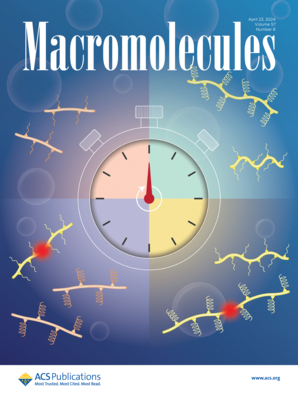Brittle-to-Ductile Transitions of Polyelectrolyte Complexes: Humidity, Temperature, and Salt
IF 5.1
1区 化学
Q1 POLYMER SCIENCE
引用次数: 0
Abstract
Polyelectrolyte complexation is an entropically driven, associative phase separation that results in a polymer-rich polyelectrolyte complex (PEC) and a polymer-poor supernatant. PECs show promise as a new class of sustainable materials since they can be processed using aqueous solutions rather than organic solvents. Previous reports have looked at the mechanical properties and glass transitions of PECs as a function of temperature, relative humidity (rH), and salt concentration (CS), but establishing a universal understanding of how these parameters affect PEC mechanics has yet to be achieved. We examined the effects of temperature, rH, and CS on the mechanical properties of PECs formed from poly(methacrylic acid) and poly(trimethyl aminoethyl methacrylate) with a goal of establishing design rules for their mechanical response. Relative humidity was shown to have the most dramatic effect on the mechanical properties, with temperature and salt concentration having far less of an impact. Furthermore, we observed that the glass transition of PECs is tied to both temperature and relative humidity, creating a glass transition rHg/Tg line that can be modulated by added salt. Finally, we looked at the thermodynamics behind the glass transition of PECs, which yielded similar energies as the condensation of water. We propose the use of water and/or salt as a low energy and efficient method of processing PECs for various applications.

求助全文
约1分钟内获得全文
求助全文
来源期刊

Macromolecules
工程技术-高分子科学
CiteScore
9.30
自引率
16.40%
发文量
942
审稿时长
2 months
期刊介绍:
Macromolecules publishes original, fundamental, and impactful research on all aspects of polymer science. Topics of interest include synthesis (e.g., controlled polymerizations, polymerization catalysis, post polymerization modification, new monomer structures and polymer architectures, and polymerization mechanisms/kinetics analysis); phase behavior, thermodynamics, dynamic, and ordering/disordering phenomena (e.g., self-assembly, gelation, crystallization, solution/melt/solid-state characteristics); structure and properties (e.g., mechanical and rheological properties, surface/interfacial characteristics, electronic and transport properties); new state of the art characterization (e.g., spectroscopy, scattering, microscopy, rheology), simulation (e.g., Monte Carlo, molecular dynamics, multi-scale/coarse-grained modeling), and theoretical methods. Renewable/sustainable polymers, polymer networks, responsive polymers, electro-, magneto- and opto-active macromolecules, inorganic polymers, charge-transporting polymers (ion-containing, semiconducting, and conducting), nanostructured polymers, and polymer composites are also of interest. Typical papers published in Macromolecules showcase important and innovative concepts, experimental methods/observations, and theoretical/computational approaches that demonstrate a fundamental advance in the understanding of polymers.
 求助内容:
求助内容: 应助结果提醒方式:
应助结果提醒方式:


